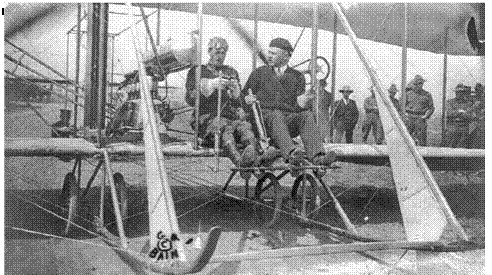1916
JANUARY 5 In the Philippine Islands, the 1st Company, 2nd Aero Squadron deploys as the first complete aviation unit assigned outside the United States.
January 17 The United States verges on the cusp of war with Germany, yet the Army Air Service only boasts 49 personnel and 25 aircraft. By the end of 1918 they will possess 19,068 aircraft, but the bulk of these are obtained from either France or England.
MARCH 15 At Columbus, New Mexico, the 1st Aero Squadron under Captain
Benjamin D. Foulois begins readying pilots and equipment to support General John J. Pershing in Mexico. This is the first American tactical air unit committed to military operations in the field and it operates a handful ofunderpowered Curtiss JN-2 biplanes.
MARCH 16 Over Mexico, a Curtiss JN-2 makes aviation history’s first recorded reconnaissance flight.
MARCH 21 In France, the French Air Service authorizes creation of the Esca – drille Americaine, better known as the
 |
Lafayette Escadrille, to recruit volunteer pilots from the United States.
MARCH 27 The 1st Aero Squadron under Captain Benjamin D. Foulois begins making routine mail and dispatch flights for General John J. Pershing’s Punitive Expedition.
April 2 In San Diego, California, Colonel William Glassford arrives to take charge of the Signal Corps Aviation School at Rockwell Field.
April 3 Command of the Aeronautics Division, Signal Corps, passes to Captain William “Billy” Mitchell.
April 5 At San Geronimo, Mexico, the 1st Aero Squadron establishes a base camp for closer cooperation with ground units commanded by General John J. Pershing.
April 7 Over Chihuahua City, Mexico, Lieutenant Herbert A. Dargue and
Captain Benjamin D. Foulois are fired upon as they deliver dispatches to the U. S. Consul; this is the first American airplane to receive hostile fire.
April 16 At Luxeuil-les-Bains (Vosages), France, the Escadrille Americaine forms from American volunteer pilots and becomes part of the French Aeronautique Militaire. It sees extensive service in skies over the Western Front and, that December, it is renamed the Lafayette Escadrille after famed Revolutionary War hero Marquis de Lafayette.
April 20 In France, Sergeant Major
Elliot Cowdin is the first American aviator to receive the Medaille Militaire.
May 18 Over Thann, Alsace Region, France, Sergeant Kiffin Yates Rockwell of the Escadrille Americaine downs a German observer craft; this is the first aerial enemy kill by an American pilot.
May 20 Lieutenant Colonel George O. Squier assumes command of the Aviation Section, Signal Corps.
June 3 In Washington, D. C., Congress passes the National Defense Act, which greatly enlarges the Signal Corps Aviation Section beyond its present 60 officers and 260 enlisted men.
June 18 Over Verdun, France, aviator H. Clyde Balsley becomes the first American shot down while flying with the Esca – drille Americaine. The French air commander subsequently flies to his airfield and presents the seriously wounded aviator with a Military Medal and a War Cross.
June 23 Near Verdun, France, pilot Victor Emmanuel Chapman, flying with the Escadrille Americaine in France, is the first American pilot killed in World War I. Previously, Chapman had been shot down seven times in six weeks and also claimed four German kills.
July 13 At Mineola, New York, the 1st Aero Company, New York National Guard, mobilizes for service along the Mexican border. They are not deployed; however, they are the first National Guard air unit requisitioned into federal service.
AUGUST 28 Major Benjamin D. Foulois reports that his 1st Aero Squadron, despite severe operational conditions, managed to complete 540 reconnaissance flights, covering 19,533 miles and staying aloft for 346 hours without serious mishap.
August 29 In Washington, D. C., Congress appropriates $14 million for use by the Signal Corps to pursue military aeronautics. NACA also receives $82,500 to construct a large aeronautical laboratory at Langley Field, Virginia.
SEPTEMBER 2 Over North Island, California, two Signal Corps aircraft, flown by Lieutenants William A. Robertson and Herbert A. Drague, successfully exchange radiotelegraph messages in flight at a distance of two miles.
September 6 Army aircraft test drop the first fragmentation bomb.
September 13 In San Diego, California, the first aeronautics course for field officers is founded at the Signal Corps Aviation School.
OCTOBER 11 In Washington, D. C., the secretaries of War and the Navy agree to create a joint Aeronautics Board to evaluate the requirements for lighter-than-air machines.
November 18-20 At Mineola, New York, seven Curtiss JN-4s ofNew York’s 1st Aero Company fly to Princeton, New Jersey, and back under Captain Raynal C. Bolling. They are there to attend a football game but also manage to showcase their cross-country flying ability to the public.
December 20 The Army’s new Balloon School is instituted at Fort Omaha, Nebraska.
DECEMBER 22 Elmer B. Sperry files a patent application for his “aerial torpedo,” an unmanned airplane piloted by one of his gyrostabilizers.
December 30 North of Hampton, Virginia, the Army establishes a new aviation school; it is now Langley Air Force Base, the Air Force’s oldest active base.










